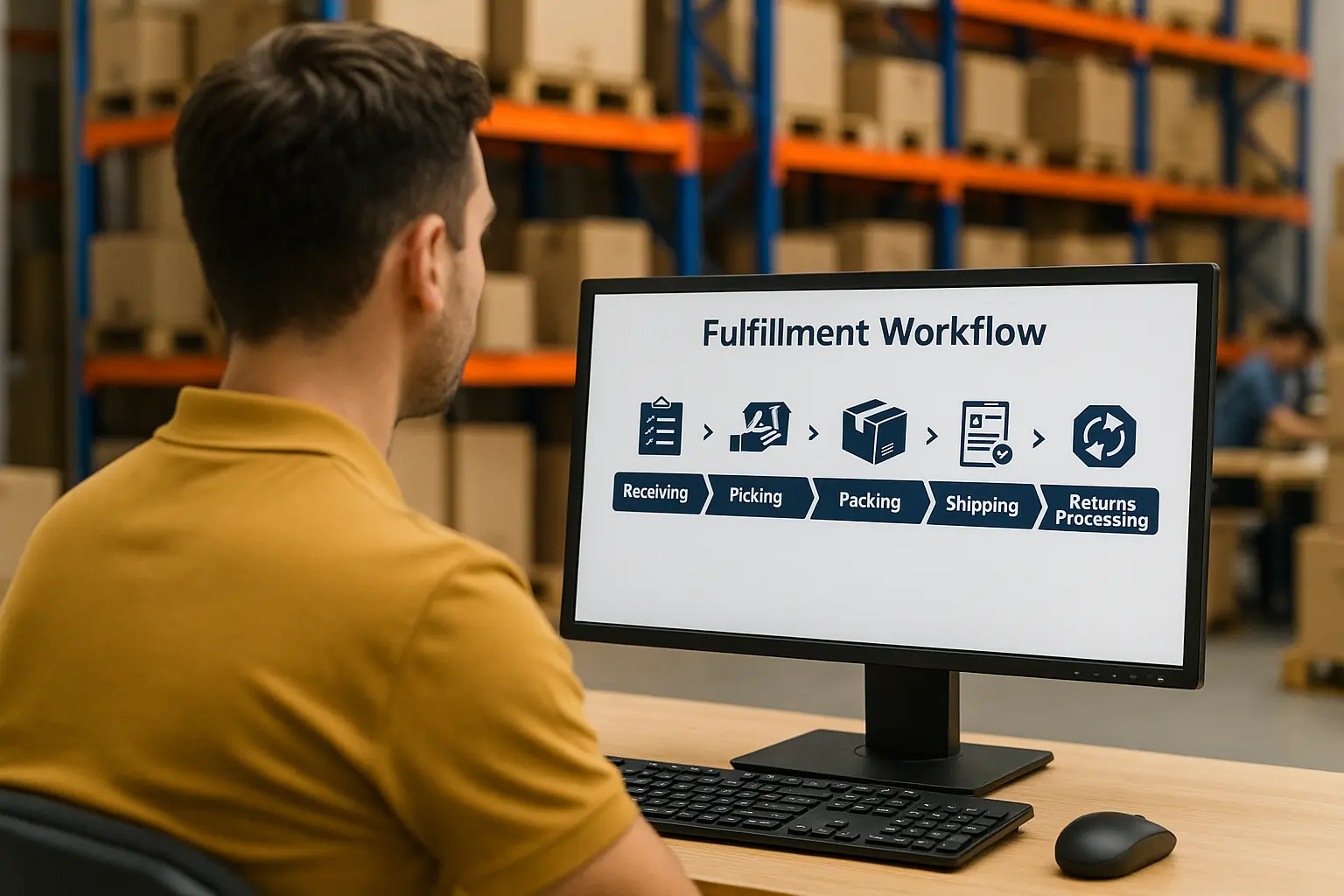Fulfillment Centers: How They Work, What They Cost, and Why Atlanta Gives Brands an Edge
A fulfillment center sits at the heart of modern ecommerce and retail logistics. It’s where your inventory is received, stored, picked, packed, and shipped—often within hours. For DTC founders, retail marketers, and procurement leads, understanding how fulfillment centers work (and when to use one) is the key to scaling without bottlenecks, accuracy issues, or missed delivery promises.
If you're managing fast-moving SKUs, subscription boxes, influencer kits, or omni-channel orders, fulfillment centers help you keep up with demand while improving speed, accuracy, and customer experience. And when your fulfillment partner is based in Atlanta—a national logistics hub—you get faster delivery times, lower freight costs, and more consistent SLAs.
This guide breaks down how fulfillment centers operate, the workflows behind the scenes, pricing drivers, common risks, and why Atlanta remains one of the best places in the country to centralize your fulfillment.
.webp)
What a Fulfillment Center Is—and Why It’s Not the Same as a Warehouse
A lot of brands mix these two terms, but they serve very different purposes.
Warehouses are built for long-term storage. Products sit for weeks or months, and the workflow is centered around pallets, cases, and bulk distribution.
Fulfillment centers, on the other hand, are designed for movement. They’re engineered for high-velocity picking, packing, shipping, returns processing, and real-time inventory accuracy. Instead of storing products indefinitely, fulfillment centers keep goods flowing in and out, with as little dwell time as possible.
They integrate directly with ecommerce platforms, retail systems, marketplaces, and EDI connections. Orders stream into the warehouse management system (WMS) automatically, and the fulfillment center handles everything from inbound receiving to final-mile carrier handoff.
For brands scaling their DTC footprint, expanding SKU counts, building bundles, or shipping nationwide, a fulfillment center becomes essential once your internal processes can’t keep pace with order volume or accuracy expectations.
When Your Brand Should Use a Fulfillment Center
Most brands reach a turning point where in-house operations become more expensive—and more error-prone—than outsourcing. Common triggers include:
Growing order volume
Once you exceed 500+ orders per month, internal teams feel the strain. Hiring, training, and managing warehouse labor quickly becomes unsustainable.
SKU or packaging complexity
Subscription boxes, influencer kits, multi-item bundles, and fragile items require specialized workflows, QA steps, and kitting expertise.
Retail or wholesale distribution requirements
Retail routing guides, labeling rules, pallet configurations, and EDI connections introduce complexity that fulfillment centers are built to manage.
Value-added services
Custom labeling, inserts, gift notes, and on-demand printing give brands differentiation but require operational workflows most internal teams can’t support efficiently.
The bigger picture: brands use fulfillment centers to maintain speed, accuracy, and SLA consistency as order volume grows. Fast delivery (including two-day ground coverage) has become table stakes—not a nice-to-have.

How a Fulfillment Center Workflow Actually Works
A fulfillment center follows a precise set of Standard Operating Procedures (SOPs) to maintain accuracy, reduce delays, and keep orders moving. Here’s what your inventory and orders typically experience inside a well-run operation.
1. Receiving Inventory
Inbound shipments arrive by pallet or case, usually scheduled in advance so the dock team can prepare. The receiving team verifies quantities, checks the bill of lading (BOL) or advance ship notice (ASN), inspects for damage, and documents overages or shortages.
Any discrepancies are communicated immediately. High-quality 3PLs provide timestamped and photographic evidence for claims or adjustments.
2. Quality Checks and Dock-to-Stock
SKUs are scanned, counted, and verified. Depending on the category, inspections may include lot numbers, expiry dates, serial numbers, or product condition checks.
Missing labels are applied, packaging issues are corrected, and inventory is officially moved into sellable bins or pallet positions. Best-in-class fulfillment centers target dock-to-stock times under 24 hours.
3. Order Management and Pick & Pack
Orders flow into the WMS through API integrations with Shopify, WooCommerce, Amazon, wholesale portals, or EDI.
Pickers receive assignments based on the most efficient routes (batch picking, wave picking, or zone picking). Every scan event—from picking to packing—maintains accuracy and traceability. Packaging materials are right-sized to reduce DIM weight, and inserts or coupons are added when applicable.
High-value, priority, or fragile orders go through additional QA steps before sealing.
4. Custom Kitting and On-Demand Printing
Fulfillment centers like All Points support both pre-built kits and on-demand builds. This covers:
- subscription boxes
- influencer PR kits
- multi-SKU bundles
- promotional packaging
- QR code cards
- branded stickers, postcards, or sleeves
Having kitting and print production under the same roof dramatically simplifies operations and cuts turnaround time.
5. Shipping and Carrier Handoffs
Labels are generated through multi-carrier rate shopping tools to optimize cost by zone, weight, and DIM. Orders are staged by carrier and scanned out for daily pickup.
This is where an Atlanta location shines: with proximity to major interstates, rail hubs, and the world’s busiest airport, carrier pickups are consistent and transit times are faster across the U.S.
6. Returns Processing
Returned items go through a standardized inspection and sorting process. Depending on condition, items are restocked, refurbished, quarantined, or scrapped. Refunds or exchanges are triggered quickly to minimize customer friction and maintain satisfaction.
7. Inventory Control and Continuous Improvement
Cycle counts, ABC classification, forward pick replenishment, and discrepancy root-cause analysis all maintain inventory accuracy. Real-time dashboards help brands track stock levels, aging inventory, and SLA performance.
This disciplined workflow keeps orders fast, accurate, and predictable—especially for brands scaling beyond early-stage fulfillment.
.webp)
What Determines Fulfillment Center Pricing
Fulfillment pricing can be straightforward when broken into its core components. Costs usually fall into activity-based fees plus pass-through shipping expenses.
Receiving
Charged per pallet, per hour, or per SKU. More complex SKUs—like those needing relabeling or 100% inspection—incur higher fees.
Storage
Monthly fees calculated by pallet, bin, or cubic foot. Faster-moving SKUs save money because they take up storage for less time. Seasonal spikes may increase space requirements.
Pick & Pack
A base fee per order plus a per-item fee. Fragile SKUs or multi-item kits can increase packing time and cost. Custom or branded packaging materials are typically billed separately.
Kitting / Assembly / Print
Fees apply per kit build, per label, or per print job. One-time setup fees cover workflow design, SOP creation, and QC instructions.
Shipping
Your largest fulfillment expense. Carrier rates depend on zones, DIM weight, service levels, and your negotiated rates. Smart packaging can reduce shipping costs by $1–$2 per order.
Onboarding and Project Fees
These cover system integrations, WMS setup, slotting design, data cleanup, and launch-day support.
Surcharges and Discounts
Peak season surcharges and storage minimums may apply. High-volume brands may qualify for volume discounts across pick rates or shipping.
Example Order Pricing Breakdown
For a typical 2-item DTC order shipped to Zone 4:
- $2.50 base pick & pack
- $0.40 for the second item
- $0.50 packaging materials
- $8.75–$11.25 shipping label (weight & DIM dependent)
- $0.40–$1.25 per insert or kitting step
Brands often underestimate how much packaging impacts DIM weight. A slight packaging redesign can save thousands per year.

Common Risks—and How Good Fulfillment Centers Prevent Them
Every logistics operation has risks, but the best 3PLs build in safeguards that prevent issues before they escalate.
Inventory Inaccuracy
Mitigation: barcode standards, ABC cycle counts, reconciliation processes, and disciplined slotting.
Delayed Order Processing
Mitigation: same-day cutoff times, wave planning, cross-trained teams, and proactive issue monitoring.
Kitting or Packaging Errors
Mitigation: SOP-backed builds, QA checkpoints, and real-time scanning validation.
Carrier Delays or Rate Spikes
Mitigation: multi-carrier rate shopping, diversified service levels, zone skipping, and annual rate reviews.
System Integration Failures
Mitigation: sandbox testing, defined API/EDI message ownership, and rollback plans.
Retail Routing Guide Non-Compliance
Mitigation: automated labeling, documentation workflows, and pre-shipment audits.
The fulfillment center you choose becomes an operational extension of your brand—so risk management and transparency matter just as much as speed.
The Atlanta Advantage: Why Location Matters
Fulfillment location has a measurable impact on speed, cost, reliability, and customer experience. Atlanta stands out as one of the strongest logistics hubs in the country for several reasons.
Two-Day Ground Reach to ~80% of U.S. Consumers
Atlanta’s central location allows economical 2-day ground transit to most of the country. This reduces reliance on expensive air services while keeping customers happy.
Lower Zone-Based Shipping Costs
Shipping from the Southeast shortens average transit zones to Midwest and Southern states—significantly cutting freight spend for most DTC brands.
Faster Transit Reduces WISMO and Stockouts
Shorter shipping windows improve conversion rates, reduce customer service tickets, and keep replenishment schedules predictable.
A Deep, Reliable Carrier Network
Atlanta’s status as a major logistics hub ensures better access to UPS, FedEx, USPS, LTL carriers, and regional partners, reducing service disruptions.
A Family-Owned 3PL Since 1995
All Points brings nearly 30 years of operational expertise as an Atlanta-based fulfillment provider. The focus is on reliability, not lowest sticker price—meaning SLA performance, transparency, and execution come first.
What You Get with All Points
Partnering with All Points gives your brand an integrated logistics ecosystem—not just a warehouse.
End-to-End Logistics Under One Roof
Ecommerce fulfillment, kitting, warehousing, distribution, and on-demand printing happen within the same operation, reducing handoffs and delays.
Configurable Workflows and Transparent Reporting
SLA dashboards, KPI visibility, and continuous improvement loops keep operations aligned with your goals.
Dedicated Onboarding and Strategic Support
Data mapping, packaging optimization, system connections, and slotting design are tailored to your SKU mix and channels.
Proven Kitting and Printing Integrations
Enterprise examples like Porsche demonstrate All Points’ ability to merge kitting with marketing collateral production seamlessly.
Scalable Ecommerce Fulfillment
Same-day dispatch, high pick accuracy, and strong WMS integrations support fast-moving DTC brands without sacrificing quality.
Primary CTA
Get a kitting quote
Secondary CTA
Download our 3PL Guide for eCommerce and Amazon Sellers
FAQ
What are the typical components of fulfillment pricing?
Receiving, storage, pick & pack, kitting, packaging materials, carrier fees, onboarding, and seasonal surcharges.
How fast do fulfillment centers ship orders?
Most operate on 24–48 hour cycles, with same-day shipping available for orders placed before cutoff.
What SLAs matter most?
Pick accuracy ≥99.5%, on-time shipping ≥98%, dock-to-stock within 24 hours, and inventory accuracy ≥99.8%.
How does location impact speed and cost?
Shipping zones shrink, transit times drop, and freight costs decrease when you fulfill from a centrally located hub like Atlanta.
What does a kitting workflow include?
Receiving, QC, assembly, labeling, scanning validation, packaging, and final QA—priced per kit or unit of labor.
Conclusion
Discover how fulfillment centers boost fast, accurate order delivery and inventory control. Learn key workflows, pricing factors, vital KPIs, risks, and why Atlanta-based 3PLs like All Points offer speed, cost savings, and expert kitting for scaling DTC brands. Optimize your logistics and delight customers today!




.webp)

.webp)
.webp)
.webp)
.webp)

